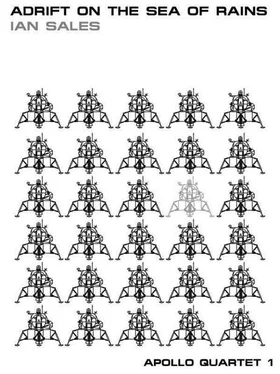Ian Sales - Adrift on the Sea of Rains
Здесь есть возможность читать онлайн «Ian Sales - Adrift on the Sea of Rains» весь текст электронной книги совершенно бесплатно (целиком полную версию без сокращений). В некоторых случаях можно слушать аудио, скачать через торрент в формате fb2 и присутствует краткое содержание. Город: Sheffield, Год выпуска: 2012, ISBN: 2012, Издательство: Whippleshield Books, Жанр: Фантастика и фэнтези, Альтернативная история, story, на английском языке. Описание произведения, (предисловие) а так же отзывы посетителей доступны на портале библиотеки ЛибКат.
- Название:Adrift on the Sea of Rains
- Автор:
- Издательство:Whippleshield Books
- Жанр:
- Год:2012
- Город:Sheffield
- ISBN:978-0-9571883-0-3
- Рейтинг книги:3 / 5. Голосов: 1
-
Избранное:Добавить в избранное
- Отзывы:
-
Ваша оценка:
- 60
- 1
- 2
- 3
- 4
- 5
Adrift on the Sea of Rains: краткое содержание, описание и аннотация
Предлагаем к чтению аннотацию, описание, краткое содержание или предисловие (зависит от того, что написал сам автор книги «Adrift on the Sea of Rains»). Если вы не нашли необходимую информацию о книге — напишите в комментариях, мы постараемся отыскать её.
When nuclear war breaks out and the nations of the Earth are destroyed, a group of US astronauts are marooned on the lunar surface. Using the “torsion field generator”, a WWII Nazi Wunderwaffe previously known as the Bell, they hope to find an alternate Earth that did not suffer nuclear armageddon. But once they do discover one, how will they return home? They have a single Lunar Module, which can carry only four astronauts into lunar orbit…
Adrift on the Sea of Rains — читать онлайн бесплатно полную книгу (весь текст) целиком
Ниже представлен текст книги, разбитый по страницам. Система сохранения места последней прочитанной страницы, позволяет с удобством читать онлайн бесплатно книгу «Adrift on the Sea of Rains», без необходимости каждый раз заново искать на чём Вы остановились. Поставьте закладку, и сможете в любой момент перейти на страницу, на которой закончили чтение.
Интервал:
Закладка:
Bartlett pulls the manual to him from under Curtis’ hand, ignoring the other man’s hurt look. Peterson thinks about intervening but then decides this is too important.
We’re going to have put in some bracing, Bartlett says. Or this thing’s going to fold like a cheap sofa.
Now that they have all agreed on a way to get into lunar orbit, the discussion moves onto the next stage of the journey: how to get to LEO. Modifying an ALM is something they can do with their hands. It is real . They have a workshop, they have tools. They may be aviators but they are also practical men: happiest when they are using their hands—control stick in one, throttle in the other. They fly by feel as much as by instruments.
But getting their modified ALM from lunar orbit to LEO is not something they can do with a wrench or a screwdriver. They can’t even rely on the ALM’s Primary Guidance Navigation Section to do the hard work for them: those fifty-five switches, forty-five circuit breakers and thirteen indicators can only be used to land an ALM on the Moon and, later, fly it to Lunar Orbit Rendezvous with a CSM, as per flightpaths programmed into the LM Guidance Computer. Perhaps they can reprogram it; they certainly cannot rewire it—the wires are so fine, using spacesuit gloves they’d just break them. They will have to calculate manually when to light the APS for TEI, and for how long, and where in the LM’s orbit about the Moon they must light it. And they must do it exactly right in order to hit a target eight thousand miles in diameter 250,000 miles away.
How the hell do I navigate? asks Peterson.
They look at him.
I? says Bartlett.
Goddamn right, replies Peterson. Who you think was going?
On your own? asks Scott. The ALM can fly four into orbit.
It’s three days to Earth, Peterson says. We put the consumables for that aboard and we’re going to be close to the weight limit. One man is safer.
We should draw straws, complains Neubeck.
You should obey goddamn orders, snaps Peterson.
You’ve got the optical telescope, says Scott, deflecting the argument. You use that. We’ll have to do some number-crunching on the computer here to get you the values to input on the DSKY, but the LGC should handle it.
Peterson had flown the ALM that brought him to Falcon Base down from lunar orbit to Mare Imbrium. In truth, he’d had little to do—the Lunar Module Guidance Computer had done everything. He’d kept his hand by the hand controller, but he’d not needed to take over.
It’s been a year since he abdicated his command, but Peterson feels the mantle of leadership settle once again on his shoulders. They might resent his decision to fly the mission himself, but they are looking at him now and it’s clear he is in charge. He organises them in teams.
Alden, who knows the maths, and Curtis, who has memorised the manuals, will calculate the variables for TEI and Earth Orbit Insertion. They will also draw up a list of the verbs and nouns Peterson will need to pilot the mission.
Peterson, because he has the most EVA experience, McKay and Fulton will salvage the fuel tanks from the ALMs on the Sea of Rains. Bartlett, Neubeck and Scott will build the equipment needed to transfer fuel from those tanks into something they can use to refuel the ALM Peterson will fly.
While Alden gets started on the calculations, Bartlett, Scott and Curtis help Peterson, McKay and Fulton into their spacesuits. It is crowded in the suiting up area, especially with three of them in bulky A7LBs, but no one complains. They are doing something; they have something to do . Peterson is ready first, his polycarbonate helmet locked on, LEVA in place, his PLSS on his back and hoses plugged into the connectors on his torso. He steps over the coaming into the airlock, turns about clumsily and watches as both McKay and Fulton have their helmets lowered onto their heads and the locking rings twisted into place.
Outside on the lunar surface, Peterson hurries ahead. All this is second nature to him, the lunar jog, leaping from one foot to the other, graceful despite the bulk of his backpack. McKay struggles to keep up, but his breathing is not enough to trigger the microphone so he appears to suffer in silence. Fulton has gone in the other direction, to fetch the LRV. They will need it to drag the tanks back to Falcon Base.
At the garden of descent stages, Peterson halts before the first ALM. Dust puffs out around his feet and then drops abruptly to the ground. It occurs to him that he will finally learn which of these gold-skirted machines landed here first. They need to check every one, and one of them has that plaque on its leg. But for now…
He reaches up and begins to strip the gold mylar from the descent stage’s side.
Peterson hung beneath the belly of a North American B-70 Valkyrie, strapped into the cockpit of his Lockheed Martin SR-91 Aurora, five minutes away from being launched on a high-speed high-altitude reconnaissance flight over the USSR. According to his instruments, the B-70 was flying at Mach 2.5 at 60,000 feet but the SR-91’s mission would take Peterson and his reconnaissance systems operator to hypersonic speeds and three times that altitude, far out of range of Soviet interceptors like the MiG-25 Foxbat. This was Peterson’s first flight in the SR-91 but he’d spent hundreds of hours in the simulator and he knew his way round this cramped cockpit with a familiarity that made him long for the simplicity of his F-108D Rapier—or even the Habu, the Lockheed SR-71 Blackbird, he’d been flying until last year. If it wasn’t for the buffeting, this could be another simulator run, another chance for him to out-think the guys running the computers, as if there weren’t enough opportunities for something to go wrong anyway with an aircraft like this, which flew so high and so fast. Nor were the Soviets going to sit and watch him as he flew over them at Mach 6, they were going to try and bring him down, send up interceptors, though they had nothing capable of speeds greater than Mach 3.6, at least both NATO and the Pentagon thought so, but there was always the chance they’d rolled out some super-black interceptor in the last few months. The USSR had nothing like the SR-91, that much was certain—the details of the Aurora’s Pulse Detonation Wave Engine were so secret not even Peterson knew how it worked, although the first time he’d seen the aircraft’s distinctive “doughnuts on a rope” jet exhaust it had come as a shock since it resembled nothing he’d ever seen before, and he could almost believe the lame-ass disinformation USAF had put out about flying saucers and aircraft reverse-engineered from UFOs which had crashed at Roswell back in 1947. There was not much Peterson could see from the SR-91’s office, as his only view of outside was provided by a television screen on his instrument panel, and the small periscope he’d use for landing this bird. Since he’d climbed into the SR-91 back on the ground back at Groom Lake, he’d been going through one checklist after another, keeping himself busy as the aircraft was carried up into the air and north to the pole and his launch point, which had just been reached according to the B-70’s commander, who told him to prep for release. So Peterson put one hand to his stick and the other to the throttle, and stared so hard at the TV screen his vision blurred until he was looking at an impressionist landscape of clouds lit by a pointillist sun. His reconnaissance systems operator, “rizzo”, seated behind him in a sealed compartment of his own, began counting down the moment until separation and, as the moment grew closer, it struck Peterson that for all the artificiality of this sealed cockpit, in which he sat in his S1030 pressure suit, and its televised view of the sky outside, this was a real mission—if an interceptor shot him down, if a missile got him, he couldn’t just raise the canopy and walk away laughing and joking. At that moment, the rizzo called out, Now; the SR-91 shook, there was a loud “clunk”, and Peterson felt his stomach lurch upwards as the plane plummeted; but the TV screen still showed only that placid sea of cirrostratus. Clear, the B-70 commander told him, and the rizzo confirmed that the mothership had banked and was climbing for the return flight to Nellis AFB. Peterson ignited the PDWE, pushed the throttle forward, and gently brought the stick back; and there was a kick in his back and acceleration pressed him into his encapsulated ejection seat, fiercer than anything the F-108D or the Habu could have pulled, and he heard his rizzo let out a grunt over the intercom. His instruments told him they were approaching Mach 6 and were already over one hundred twenty thousand feet as they arced over the North Pole, and crossed the Arctic Ocean towards the Kara Sea. They were firmly in the mission envelope now, flying hypersonic thirty-five miles above the ground, halfway to space, the TV screen as dark as night, but he was on autopilot and would be all the way south one thousand eight hundred miles into the USSR. The Soviets were up to something near Saratov, but the last two satellites to over-fly the area had been shot down by Soviet hunter-killer birds, and the Pentagon didn’t want to risk another one—not that the SR-91 had a much lower price-tag than a spy satellite, but it was easier to get into the air. At two hundred thousand feet they started on their loop down to the Caspian Sea, which would take them back up over Poland and Norway, and over Saratov his rizzo says, Wow look at all them birds; and Peterson himself can see on the PIR display lines and lines of Tupolev Tu-22KP Blinders on the dispersal areas at Engels Air Force Base. A week later, those Tupolevs were flying south, and they sent Peterson off again from Groom Lake to find out what they were up to, and he watched as the Tu-22KPs repeatedly flew across Georgia and Azerbaijan and into northern Iraq, where they fired their As-4 Kitchen anti-radiation missiles in support of a ground invasion. Peterson went back a number of times and from on high he witnessed the Soviet tanks rumble into the oilfields near Mosul and Kirkuk, the clashes between the Turks and the Soviets on the border near Silopi and the Habur frontier gate, and even the NATO forces clearing the area of Kurds and putting them in camps. It got nasty down there, though from two hundred thousand feet up all he could see were fires and thick black smoke, battlefield wreckage and sprawling bases of Soviet troops. They sent up MiG-25s each time, but the interceptors topped out at eighty thousand feet and Peterson could only grin and wonder why they even bothered.
Читать дальшеИнтервал:
Закладка:
Похожие книги на «Adrift on the Sea of Rains»
Представляем Вашему вниманию похожие книги на «Adrift on the Sea of Rains» списком для выбора. Мы отобрали схожую по названию и смыслу литературу в надежде предоставить читателям больше вариантов отыскать новые, интересные, ещё непрочитанные произведения.
Обсуждение, отзывы о книге «Adrift on the Sea of Rains» и просто собственные мнения читателей. Оставьте ваши комментарии, напишите, что Вы думаете о произведении, его смысле или главных героях. Укажите что конкретно понравилось, а что нет, и почему Вы так считаете.











![Edward Ellis - Adrift on the Pacific - A Boys [sic] Story of the Sea and its Perils](/books/753342/edward-ellis-adrift-on-the-pacific-a-boys-sic-s-thumb.webp)
